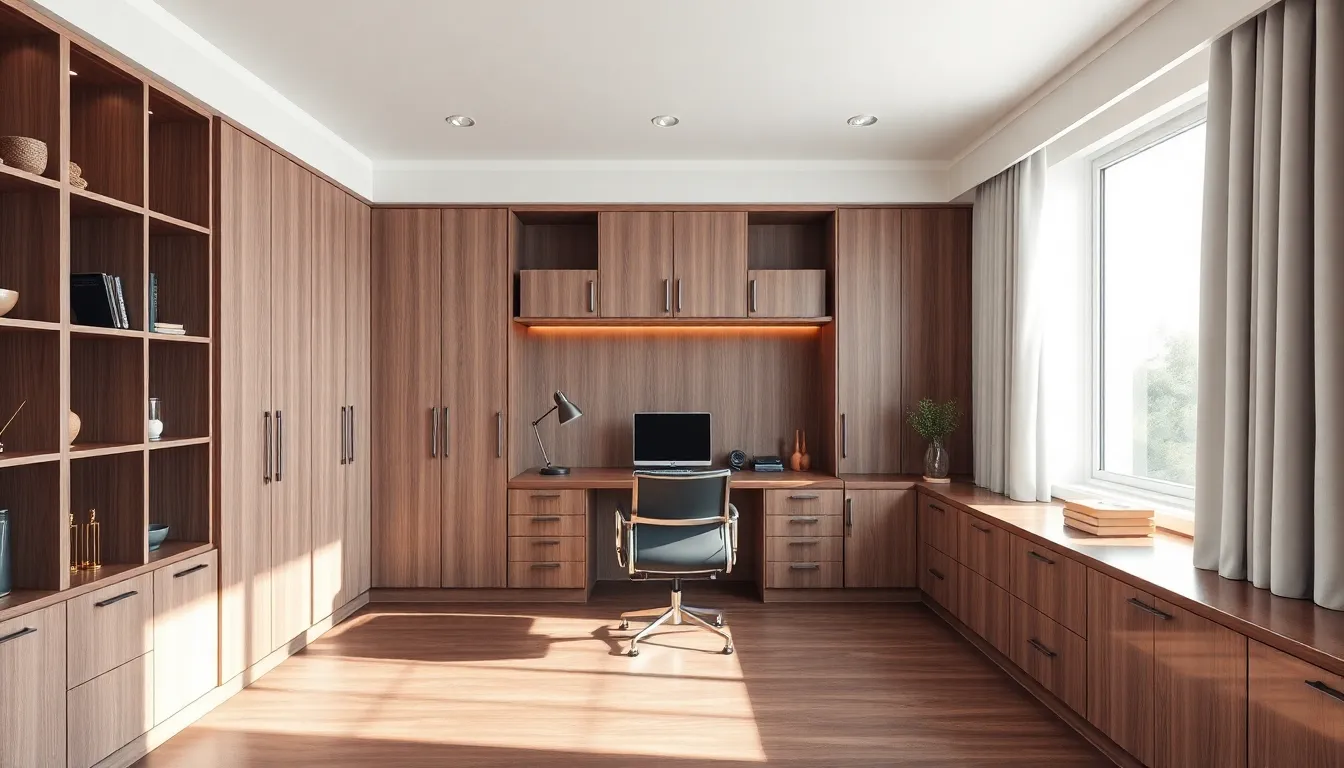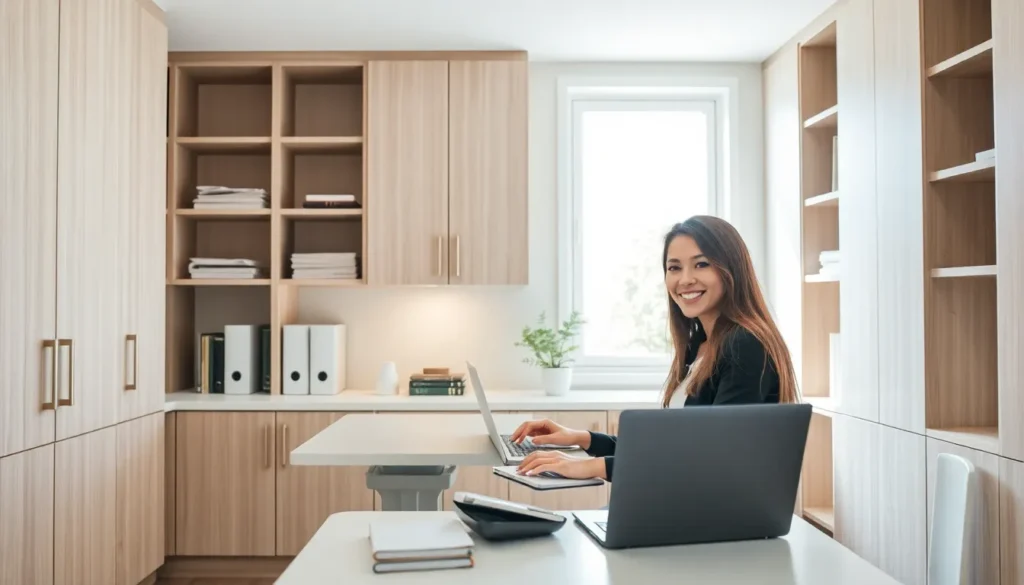Table of Contents
ToggleIn the era of remote work, a clutter-free home office isn’t just a luxury; it’s a necessity. Imagine transforming that corner of your living room into a productivity powerhouse with built-in office cabinets. These sleek storage solutions don’t just hide the chaos of paperwork and snacks; they elevate your workspace from “meh” to magnificent.
Not only do built-in cabinets maximize space, but they also make you feel like a CEO—minus the corner office and the fancy coffee machine. With a dash of creativity and a sprinkle of organization, you can design a home office that screams efficiency and style. So why settle for a desk piled high with yesterday’s to-do list when you can have a custom-built haven that inspires success?
Benefits Of Home Office Built In Office Cabinets
Home office built-in cabinets offer various advantages, significantly contributing to a productive workspace. These storage solutions maximize efficiency and organization, making them essential for anyone working remotely.
Maximizing Space
Maximized space is one key benefit of built-in cabinets. They utilize vertical and horizontal surfaces in ways that freestanding furniture cannot. Custom designs can fit snugly into corners or under eaves, making every inch of the office usable. A clutter-free environment encourages focus and minimizes distractions. Additionally, built-in cabinets eliminate the need for bulky furniture, thus enhancing the overall flow of the room. Homeowners can create a seamless look by integrating cabinets with existing decor.
Enhancing Organization
Built-in cabinets enhance organization through strategic design and functionality. They offer designated spaces for office supplies, documents, and technology, promoting tidiness. Various compartments and shelves can accommodate everything from binders to electronics, helping maintain a clear work surface. Custom shelving options allow for personal preferences, making it easy to access frequently used items. When everything has its place, efficiency increases, leading to higher productivity. Effective organization fosters a sense of control, which is vital for successful remote work.
Design Considerations

Designing a home office with built-in cabinets involves careful planning to maximize utility and aesthetics.
Selecting Materials
Materials impact both functionality and visual appeal. Wood is popular for its durability and classic look, while metal offers a sleek, modern alternative. MDF provides versatility, allowing for intricate designs at lower costs. It’s important to choose materials that complement existing decor and withstand daily wear. Bamboo represents an eco-friendly option, appealing to those prioritizing sustainability. Consider laminate surfaces for easy cleaning and enduring finishes. Custom cabinetry may require higher-quality materials but results in a polished finish. Lastly, combining different materials can create unique contrasts and enrich the workspace experience.
Color Schemes And Finishes
Color schemes play a significant role in setting the mood. Neutral tones like white and gray provide a calming backdrop, making spaces feel larger. Bright colors can inject energy, stimulating creativity and focus. Combining colors creates visual interest and can define different areas within the office. Matte finishes exude sophistication, while glossy ones may reflect light, adding dimension. Experimenting with textures can enhance tactile experiences, contributing to a lively environment. For cohesion, ensure cabinet colors align with wall hues and furniture styles. Ultimately, consider personal preferences to create an inspiring workspace that reflects individual style.
Installation Process
Installing built-in office cabinets involves careful planning and a clear understanding of the necessary steps. Selecting the right approach is crucial for achieving the desired outcome.
DIY Vs. Professional Installation
Choosing between DIY and professional installation depends on several factors. DIY installation allows for personal customization, offering flexibility in design and execution. Individuals with basic carpentry skills can often manage this task effectively. On the other hand, professional installation guarantees optimal results, particularly for complex designs or when high-quality finishes are essential. Contractors bring expertise and experience, ensuring accurate measurements and seamless integration. Evaluating time, skills, and budget can aid in making the best decision.
Tools And Materials Needed
Gathering the right tools and materials is essential for a successful installation. Common tools include a drill, level, saw, and measuring tape. A circular saw or miter saw may be necessary for cutting materials to precise sizes. Materials often feature wood, plywood, or MDF boards to construct cabinets. Hinges, drawer slides, and handles enhance functionality and ease of use. Additionally, screws, adhesive, and wood glue ensure stability and durability. Having everything on hand before starting helps create a smooth and efficient installation process.
Maintenance Tips
Maintaining built-in office cabinets ensures longevity and aesthetic appeal. Proper care contributes to a productive workspace.
Cleaning And Care
Dusting cabinets weekly prevents buildup and keeps surfaces fresh. Use a microfiber cloth for gentle cleaning, as it avoids scratches. For deeper cleans, a mixture of warm water and mild soap cleans surfaces without damaging finishes. Avoid harsh chemicals that could cause deterioration. Stains may require specific treatments, so consulting the manufacturer’s guidelines helps maintain integrity. Regularly check for spills and promptly address them to prevent permanent marks.
Regular Inspections
Conducting regular inspections helps identify potential issues early. Check for signs of wear, such as loose hardware or damaged surfaces. Tightening screws and hinges prevents further deterioration, supporting functionality. Inspect the integrity of paint or varnish to ensure protection against moisture. Noticing and addressing issues before they escalate fosters a pristine environment. Keeping a maintenance schedule aids in sustaining the cabinets’ condition over time.
Investing in built-in office cabinets can significantly enhance a home office’s functionality and aesthetic appeal. By maximizing space and promoting organization, these cabinets help create a workspace that inspires productivity and creativity.
With thoughtful design choices and proper installation, individuals can achieve a seamless look that complements their personal style. Regular maintenance ensures these cabinets remain both beautiful and functional over time.
Ultimately, a well-organized home office contributes to a more focused work environment, making it easier for remote workers to thrive in their professional endeavors. Embracing this approach can lead to a more enjoyable and efficient work experience.







